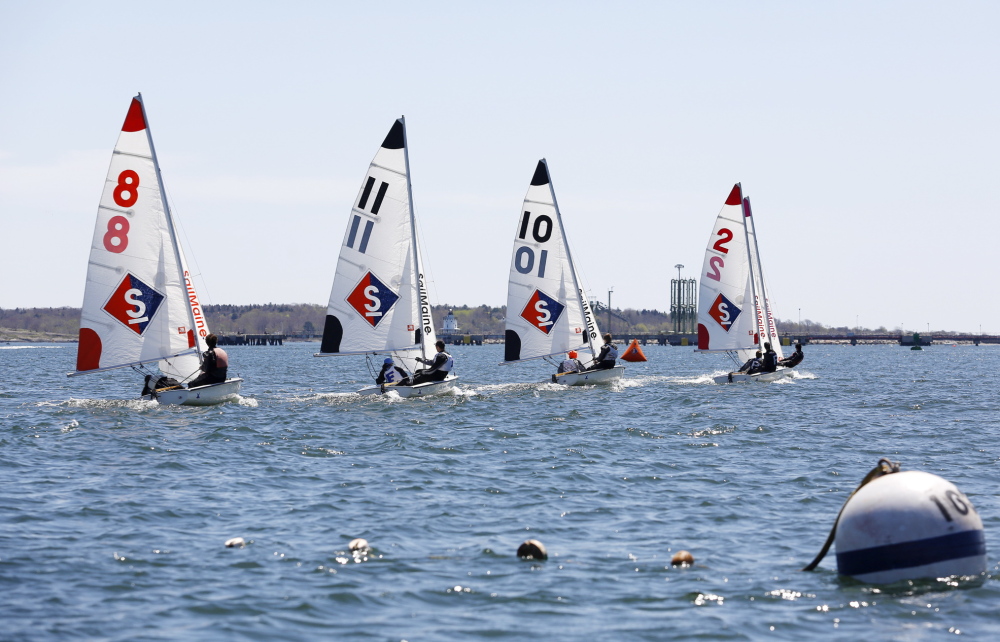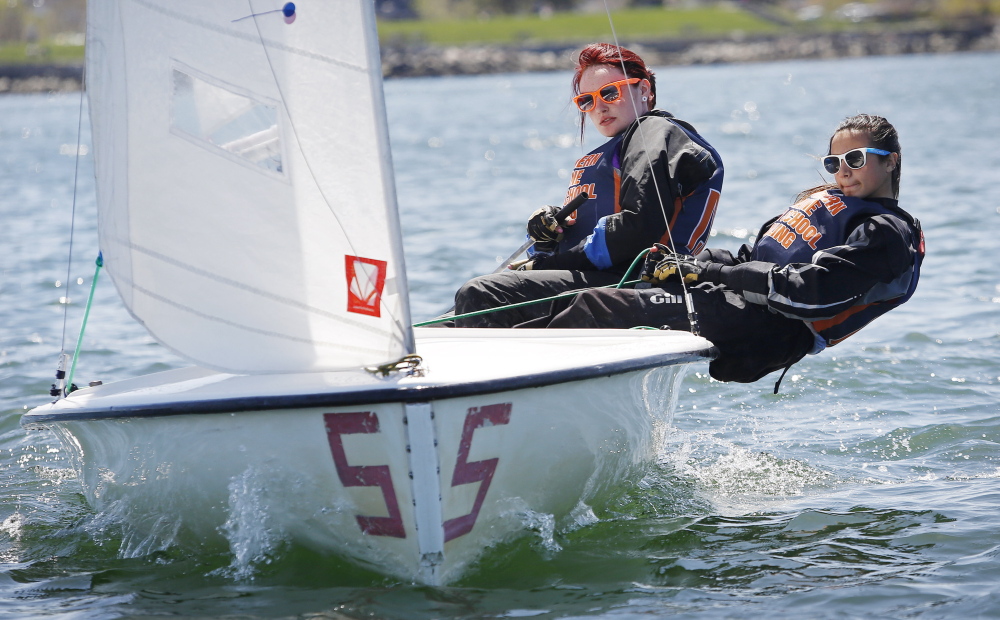Kelley Frumer leaned so far back on her 420-class sailboat that the waves lapped her ponytail – just the way she likes it – while she raced Sunday in the Northern New England Regatta in Portland Harbor.
The maneuver – called “hiking out” – involves the two-person crew on the dinghy-sized sailboats tucking their feet into straps and leaning backward, nearly parallel to the water, so the boat can take full advantage of the wind.
“It’s a rush. While I’m ‘hiking out,’ my hair is in the water, and maybe a wave goes over my face. It’s very invigorating,” Frumer said.
Frumer, a freshman at Waynflete School, and Elizabeth Newberry, a senior at Bonny Eagle High School, were teammates in the regatta, placing among the top finishers in numerous races Saturday and Sunday. The two sailed for the Southern Maine high school conglomerate, a group of teams culled from several high schools in the region.
Thirteen teams with about 70 high school participants competed Sunday, including teams from Maine, New Hampshire and Massachusetts. Each race took about 20 to 45 minutes, depending on wind speed.
The high school sport combines mental strategy with teamwork, responsibility and empowerment. Unlike in traditional sports, no coaches can call time outs or scream directions, parent organizer Jim Atwood noted. Once the race starts, it’s up to each team to figure out the best strategy.
So while sailing evokes images of blue skies, calm seas and Hawaiian music, the races are intense and sweaty.
“It’s like doing aerobics while someone is spraying you with cold water, but you have to play chess at the same time,” Atwood said.
Newberry said a lot of effort goes into positioning the boats to steal a competitor’s wind, and to not get caught up in “dirty air,” which means your rival has shielded you from most of the wind.
“There’s a lot of yelling going on. There’s no such thing as quiet sailing,” said Newberry, who has sailed as long as she can remember. The small boats cruise within a few feet of one another during races, as they scramble around a short course designed to challenge each team’s ability to sail in headwinds and tailwinds.
From the shore it looks serene, but up close the sailors grunt, pull on ropes and bound about the boat.
“When it’s really windy, it literally turns into wrestling,” said Caleb Niles, a Deering High School freshman.
The weather can be unpredictable, especially during a Maine spring. A few weeks ago, during another race, a passing storm cloud dumped mothball-sized hail on the boats for a few minutes. The race did not stop.
The start of each race is a jostling, chaotic affair, as each team tries to time it just right so the boat is as close to the starting line as possible when the race begins. Unlike a running race, where competitors are at a standstill when the gun goes off, the boats are in constant motion before the race starts. If a boat crosses the starting line prior to the whistle, it has to circle back and cross the line again, wasting precious time.
Frumer said she’s been knocked off the boat during races when the “boom” – the long metal part parallel to the boat that the sail attaches to – moves as the wind shifts.
“That’s not so much fun,” she said.
The winds can suddenly shift, so a wise racer is always monitoring the wind.
“Sometimes it’s really hard to tell when the wind changes direction, and you don’t even know it until the wind hits you,” Frumer said.
The students said they love racing and the camaraderie of being part of a team, although one downside is universally loathed.
The wet suits they must wear when the water is cold don’t smell so nice.
“They are really, really stinky, worse than hockey gear,” Frumer said, laughing.
Joe Lawlor can be contacted at 791-6376 or at:
jlawlor@pressherald.com
Twitter: @joelawlorph
Send questions/comments to the editors.





Comments are no longer available on this story